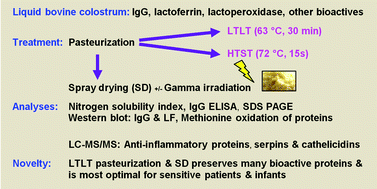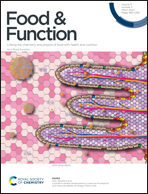Bioactive proteins in bovine colostrum and effects of heating, drying and irradiation
Abstract
Bovine colostrum (BC) contains bioactive proteins, such as immunoglobulin G (IgG), lactoferrin (LF) and lactoperoxidase (LP). BC was subjected to low-temperature, long-time pasteurization (LTLT, 63 °C, 30 min) or high-temperature, short-time pasteurization (HTST, 72 °C, 15 s) and spray-drying (SD), with or without γ-irradiation (GI, ∼14 kGy) to remove microbial contamination. Relative to unpasteurized liquid BC, SD plus GI increased protein denaturation by 6 and 11%, respectively, increasing to 19 and 27% after LTLT and to 48% after HTST, with no further effects after GI (all P < 0.05). LTLT, without or with GI, resulted in 15 or 29% denaturation of IgG, compared with non-pasteurized BC, and 34 or 58% for HTST treatment (all P < 0.05, except LTLT without GI). For IgG, only GI, not SD or LTLT, increased denaturation (30–38%, P < 0.05) but HTST increased denaturation to 40%, with further increases after GI (60%, P < 0.05). LTLT and HTST reduced LP levels (56 and 81% respectively) and LTLT reduced LF levels (21%), especially together with GI (47%, P < 0.05). Denaturation of BSA, β-LgA, β-LgB and α-La were similar to IgG. Methionine, a protective amino acid against free oxygen radicals, was oxidised by LTLT + GI (P < 0.05) while LTLT and HTST had no effect. Many anti-inflammatory proteins, including serpin anti-proteinases were highly sensitive to HTST and GI but preserved after LTLT pasteurization. LTLT, followed by SD is an optimal processing technique preserving bioactive proteins when powdered BC is used as a diet supplement for sensitive patients.



 Please wait while we load your content...
Please wait while we load your content...